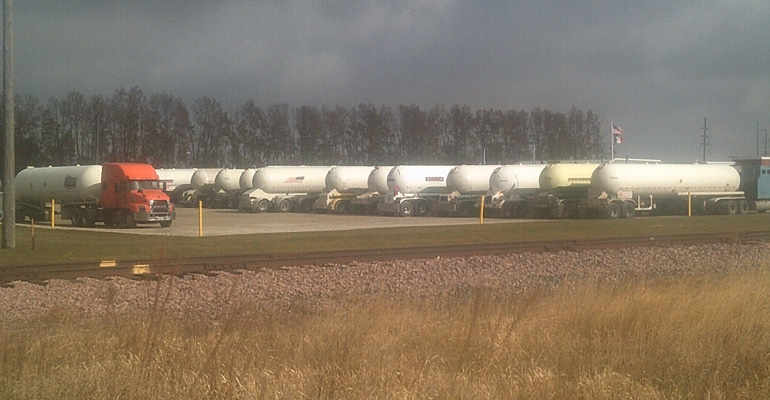November 7, 2019

Beginning last week and now this week, supplies of propane in Iowa are running tight, as farmers are drying wetter-than-normal crops coming out of fields. Increased demand for propane for grain drying this fall is compounded by widespread cold temperatures, which have many people already heating their homes. Heaters are also running in hog barns.
The heavier demand is causing long lines as delivery trucks wait to load at pipeline terminals. More farmers are reporting delays in liquid propane (LP) delivered to farms as grain dryers are running out of gas. Some are reporting three- and four-day delays in getting on-farm LP tanks refilled.
On Oct. 31, Iowa Gov. Kim Reynolds signed a proclamation easing propane delivery rules pertaining to hours of service for trucks hauling propane. The temporary suspension of certain policies limiting how long drivers can be behind the wheel will expire Nov. 30 at midnight.
Trucks waiting hours to fill
On Nov. 4, empty propane tanker trucks were waiting to fill up at the pipeline terminal at Sanborn in northwest Iowa.
"All of the big 90,000-gallon storage tanks at the Mapco pipeline terminal at Sanborn were empty," said Loren Flaugh, who took photos and sent them to Wallaces Farmer. "Mapco is loading one truck at a time, even though they have three loading racks at this terminal. The propane is coming directly from the pipeline and being loaded into the one tanker truck that's loading. It takes about 60 minutes to load one truck."
With a later-maturing crop this fall, farmers are having to dry corn that's harvested at 18% to 24% moisture content, sharply above the preferred 15%. Soybeans are also coming out of fields wetter than normal and need to be dried to safe storage moisture.
At the Oneok terminal in Clear Lake in northern Iowa, tank truck drivers have had to wait several hours for a shipment of propane to come to the terminal through the pipeline. "What a house uses in an entire heating season, a farmer will use in two days," says one driver, referring to amounts of LP gas usage.
System can't meet demand
Despite the shortage in Iowa and Minnesota, Midwest propane supplies total 26.5 billion barrels, the federal Energy Information Agency reported in late October. That's slightly higher than a year ago. Thus, the strong demand surges and supply challenges are somewhat of a logistical or transportation issue. The pipeline system shipping LP to Iowa from the southwest U.S. can't keep up with the increased demand.
Randy Ellis, with C.H. Wilson Truck Transport of Charles City, has been crisscrossing Iowa for about three weeks, going to different terminals to get LP gas and deliver it to farmers. On Nov. 4, he was stuck in a long line waiting for a shipment of propane to come via pipeline.
"As a company with the number of trucks we have, we're geared to handle high demand in the fall. But when there's no supply coming through the pipe. All we can do is sit and wait, or drive around the state and try to find propane at some other terminal."
Prices move higher
Another trucking company, LB Transport of Buffalo Center, has also run into supply issues. The terminals at Sanborn and Rock Rapids in northwest Iowa are out of gas and are relying on the pipeline.
At the Jackson, Minn., terminal recently, drivers for LB Transport had to wait five hours to load. While these drivers and trucking companies have faced some shortages in past years, they say they haven't seen anything like this year. They hope something can be done to avoid repeat shortages in future years.
They also say the co-ops and retailers who are buying LP gas will have to raise prices charged to farmers, homeowners and other customers to offset the waiting time and transportation delays. Thus, propane prices will go higher.
While the governor's proclamation to relax the delivery driver rules in Iowa will help temporarily, the long-term solution isn't being addressed, say industry sources. They say there needs to be reform to the industry's infrastructure.
State and local officials need to change zoning codes to allow LP marketers to build more local storage. If marketers could build a local facility to store larger amounts of propane, it would ease the pressure put on the supply sent by pipeline companies. As a temporary solution, some retail LP dealers are switching their bigger customers to using larger storage tanks on farms and at businesses.
Solution to problem
Several years ago, some retailers installed extra onsite storage so they would be less dependent on the three main propane pipelines that deliver LP to Iowa. Deb Grooms, executive director of the Iowa Propane and Gas Association, says the greater-than-usual demand this fall is triggering the delays in delivery. "In a normal year, there is a more gradual harvest moving from south to north, but this year multiple states are harvesting at the same time, and more drying is needed for the crops," she notes.
The industry says there is propane available in the Midwest, but transportation and pipeline capacity limits are creating logistical challenges, says Iowa Secretary of Agriculture Mike Naig. "The Iowa Department of Agriculture is working with IPGA to monitor the situation and explore options to expedite delivery of LP to homes, farms and businesses," he adds. "The industry is tracking potential interruptions to rail or pipeline distribution, and working with those industries to help facilitate the movement of propane during peak demand periods."
About the Author(s)
You May Also Like






